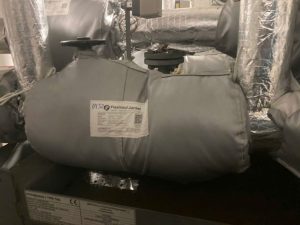Insulation jackets (or removable insulation blankets) are a flexible and effective thermal insulation solution for piping systems, valves, and industrial equipment. However, they degrade over time, reducing thermal efficiency, causing energy waste, and posing potential risks. Recognizing the signs of damage for timely maintenance and replacement is key for businesses to maintain stable operations and optimize costs.
Why You Should Regularly Inspect and Replace Insulation Jackets
Operating in harsh industrial environments with high temperatures, chemicals, and physical impacts, insulation jackets inevitably experience wear and tear. Ignoring signs of damage can lead to serious consequences:
- Energy Loss: Heat leaks into the environment, forcing the system to consume more energy to maintain the required temperature, leading to soaring electricity bills.
- Safety Risks: Hot equipment surfaces can cause burns to operating personnel. Leaking chemicals or grease soaking into the insulation jacket also increases the risk of fire.
- Reduced Equipment Lifespan: Unstable temperatures can negatively affect the lifespan of valves, pipes, and related machinery.
Therefore, timely maintenance and replacement of insulation jackets is a smart investment to protect assets and optimize production efficiency.
5 Signs It’s Time to Replace Your Insulation Jackets
Regular visual inspection is the easiest way to assess the condition of an insulation jacket. Pay attention to the following 5 important warning signs:
1. Physical Surface Damage
These are the most obvious signs, indicating that the outer protective layer has been compromised:
- Tears, punctures, or fraying: Caused by mechanical impact or abrasion, exposing the internal insulation material.
- Broken or loose stitching: High temperatures or chemicals can cause the sewing thread to degrade, allowing the layers of the insulation jacket to separate and no longer form a tight seal.
- Damaged straps or fasteners: Fastening components like D-ring straps, Velcro, or hooks that are broken or have lost their tightening ability will cause the jacket to shift, creating gaps that lead to heat loss.
2. Deformation and Structural Degradation
A change in shape is a warning sign about the quality of the internal insulation layer:
- Compression, sagging, or loss of loft: The insulation material (like ceramic or glass wool) becomes compressed over time or due to moisture, significantly reducing its ability to resist heat flow.
- Sagging or no longer fitting snugly: The insulation jacket loses its shape and can no longer tightly envelop the equipment, creating “thermal bridges” that allow energy to escape quickly.
3. Signs of Contamination and Moisture
The infiltration of substances from the external environment is a silent but extremely dangerous destructive factor:
- Oil, grease, or chemical saturation: When these liquids soak in, they not only reduce insulation performance but can also destroy the material’s structure and increase the risk of fire.
- Dampness and mold: Prolonged moisture accumulation causes the insulation material to clump and lose its effectiveness, and can also cause corrosion on the surface of the protected equipment inside.
4. Noticeable Decline in Insulation Performance
This is a direct consequence of the above damages and the most urgent sign that action is needed:
- Unusually hot outer surface: Using an infrared thermometer or by touch (carefully), you notice the surface temperature is significantly higher than the standard or compared to when it was newly installed.
- Increased ambient temperature: The workspace becomes hotter due to excessive heat loss.
- Sudden increase in energy costs: The system has to work harder to compensate for the lost heat.
5. Exceeding the Manufacturer’s Recommended Lifespan
Every type of insulation jacket has an expected lifespan. Even if there are no obvious signs of damage, using a product beyond its service life poses risks to performance and safety.
Suggested Maintenance and Replacement Schedule for Insulation Jackets
The actual replacement cycle depends on the operating environment (temperature, humidity, chemicals), frequency of removal and reinstallation, and product quality. However, you can refer to the following proactive maintenance schedule:
- Visual Inspection (Monthly/Quarterly): Check for signs of tears, deformation, contamination, and the proper fit of the insulation jacket.
- Surface Temperature Measurement (Quarterly/Semi-Annually): Use a specialized temperature measurement device to assess insulation performance and compare it with baseline data.
- Plan for Replacement:
- Harsh environments (chemicals, strong vibrations, extreme temperatures): Consider replacement after 1-3 years.
- Standard operating environments: The lifespan can extend from 3-5 years or longer, depending on the results of periodic inspections.
Proactive maintenance planning not only helps optimize the product’s lifecycle but also ensures your system always operates at peak performance. If you notice any of the signs mentioned above, contact experts immediately for advice on suitable repair or replacement solutions.
Request consultation and quotation now!Frequently Asked Questions
Can a torn insulation jacket be repaired?
Repairs are possible for minor damage like small surface tears or loose stitching. However, if the internal insulation material is damaged, deformed, or saturated with chemicals, a complete replacement is the safest and most effective solution.
What is the average lifespan of a thermal insulation blanket?
The average lifespan is typically 3-5 years under standard operating conditions. This can decrease to 1-3 years in harsh environments (extremely high temperatures, chemicals, strong vibrations).
What are the consequences of not replacing a damaged insulation jacket?
It causes three main losses: energy waste leading to high operating costs, increased workplace safety risks (burns, fire hazards), and a reduced lifespan for the protected equipment.
Why does the outer surface of an insulation jacket get hot?
A hot outer surface is a clear sign that the internal insulation material has degraded (due to compression, sagging, or moisture), losing its ability to retain heat effectively and allowing thermal energy to escape.
What should be done if an insulation jacket is found to be saturated with oil or chemicals?
It should be immediately removed and replaced. Continuing to use it not only results in poor insulation performance but also poses a serious fire hazard.










